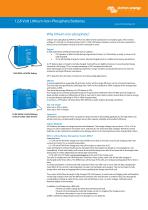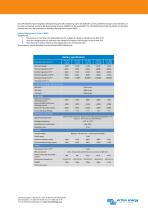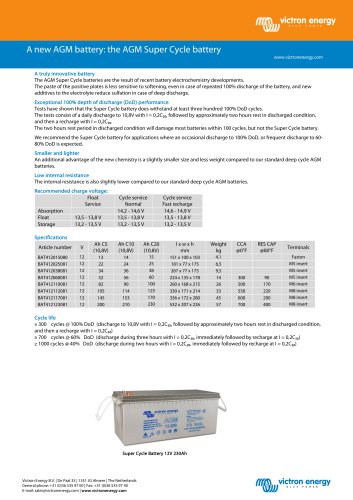
Excertos do catálogo

12,8 Volt Lithium-Iron-Phosphate Batteries Why lithium-iron-phosphate? Lithium-iron-phosphate (LiFePO4 or LFP) is the safest of the mainstream li-ion battery types. The nominal voltage of a LFP cell is 3,2V (lead-acid: 2V/cell). A 12,8V LFP battery therefore consists of 4 cells connected in series; and a 25,6V battery consists of 8 cells connected in series. Rugged A lead-acid battery will fail prematurely due to sulfation: • If it operates in deficit mode during long periods of time (i.e. if the battery is rarely, or never at all, fully charged). • If it is left partially charged or worse, fully discharged (yacht or mobile home during wintertime). A LFP battery does not need to be fully charged. Service life even slightly improves in case of partial charge instead of a full charge. This is a major advantage of LFP compared to lead-acid. Other advantages are the wide operating temperature range, excellent cycling performance, low internal resistance and high efficiency (see below). LFP is therefore the chemistry of choice for very demanding applications. Efficient In several applications (especially off-grid solar and/or wind), energy efficiency can be of crucial importance. The round trip energy efficiency (discharge from 100% to 0% and back to 100% charged) of the average leadacid battery is 80%. The round trip energy efficiency of a LFP battery is 92%. The charge process of lead-acid batteries becomes particularly inefficient when the 80% state of charge has been reached, resulting in efficiencies of 50% or even less in solar systems where several days of reserve energy is required (battery operating in 70% to 100% charged state). In contrast, a LFP battery will still achieve 90% efficiency under shallow discharge conditions. Size and weight Saves up to 70% in space Saves up to 70% in weight 12,8V 300Ah LiFePO4 Battery (only one data cable shown) Expensive? LFP batteries are expensive when compared to lead-acid. But in demanding applications, the high initial cost will be more than compensated by longer service life, superior reliability and excellent efficiency. Endless flexibility LFP batteries are easier to charge than lead-acid batteries. The charge voltage may vary from 14 V to 15 V (as long as no cell is subjected to more than 4,2 V), and they do not need to be fully charged. Therefore several batteries can be connected in parallel and no damage will occur if some batteries are less charged than others. With or without Battery Management System (BMS)? Important facts: 1. A LFP cell will fail if the voltage over the cell falls to less than 2,5V (note: recovery by charging with a low current, less than 0,1C, is sometimes possible). 2. A LFP cell will fail if the voltage over the cell increases to more than 4,2V. Lead-acid batteries will eventually also be damaged when discharged too deeply or overcharged, but not immediately. A lead-acid battery will recover from total discharge even after it has been left in discharged state during days or weeks (depending on battery type and brand). 3. The cells of a LFP battery do not auto-balance at the end of the charge cycle. The cells in a battery are not 100% identical. Therefore, when cycled, some cells will be fully charged or discharged earlier than others. The differences will increase if the cells are not balanced/equalized from time to time. In a lead-acid battery a small current will continue to flow even after one or more cells are fully charged (the main effect of this current is decomposition of water into hydrogen and oxygen). This current helps to fully charge other cells that are lagging behind, thus equalizing the charge state of all cells. The current which flows through a fully-charged LFP cell however, is nearly zero, and lagging cells will therefore not be fully charged. Over time the differences between cells may become so extreme that, even though the overall battery voltage is within limits, some cells will fail due to over- or under voltage. Cell balancing is therefore highly recommended. In addition to cell balancing, a BMS will: Prevent cell under voltage by timely disconnecting the load. Prevent cell overvoltage by reducing charge current or stopping the charge process. Shut down the system in case of over temperature. A BMS is therefore indispensable to prevent damage to Li-ion batteries
Abrir o catálogo na página 1
Our LFP batteries have integrated cell balancing and cell monitoring. Up to ten batteries can be paralleled and up to four batteries can be series connected, so that a 48V battery bank of up to 3000Ah can be assembled. The cell balancing/monitoring cables can be daisy-chained and must be connected to a Battery Management System (BMS). Battery Management System (BMS) The BMS will: 1. Disconnect or shut down the load whenever the voltage of a battery cell falls to less than 2,5V. 2. Stop the charging process whenever the voltage of a battery cell increases to more than 4,2V. 3. Shut down the...
Abrir o catálogo na página 2Todos os catálogos e folhetos Victron Energy
-
Blue Smart IP22Charger
1 Páginas
-
Blue Smart Charger
2 Páginas
-
MPPT 150/45 up to MPPT 150/70
2 Páginas
-
MPPT 250/60 and MPPT 250/70
2 Páginas
-
BMV-712 Smart
2 Páginas
-
Centaur Charger
2 Páginas
-
Quattro Inverter/Charger120V
2 Páginas
-
Telecom Batteries
1 Páginas
-
ArgoDiode Battery Isolators
1 Páginas
-
Cyrix-i 400A 12/24V and 24/48V
2 Páginas
-
Cyrix-ct 12/24V120A and 230A
2 Páginas
-
Cyrix Li-ion 230A series
2 Páginas
-
Cyrix Li-ion 120 A series
2 Páginas
-
BatteryProtect
1 Páginas
-
BlueSolar Polycrystalline Panels
1 Páginas
-
BlueSolar Monocrystalline Panels
1 Páginas
-
Skylla 24/48V
2 Páginas
-
ARGO Diode Battery Combiners
1 Páginas
-
Gel and AGM Batteries
4 Páginas
-
Color Control GX
4 Páginas
-
Shore Power Cable
1 Páginas
-
Battery Balancer
2 Páginas
-
Lynx Shunt VE.Can
32 Páginas
-
2021 Marine
120 Páginas
-
BlueSolar PWM-Pro
1 Páginas
-
BlueSolar MPPT 100/30 & 100/50
1 Páginas
-
Filax 2
1 Páginas
-
Off-grid, Back-up and Island systems
92 Páginas
-
Mobility
8 Páginas
-
Energy Storage
64 Páginas
-
EasyPlus
4 Páginas
-
Phoenix Battery Charger
2 Páginas
-
Autotransformer 120/240V -
2 Páginas
-
BatteryProtect 65A/100A/220A
1 Páginas
-
BatteryProtect 48V-100A
1 Páginas
-
2016 Marine
108 Páginas
-
Skylla-i Battery Charger 24V
2 Páginas
-
EasySolar 12V & 24V, 1600VA
2 Páginas
-
Quattro 3kVA - 10kVA 230V
2 Páginas
-
Isolation Transformers
2 Páginas
-
Autotransformer 32A and 100A
2 Páginas
-
Phoenix Inverter 1200VA - 5000VA
2 Páginas
-
Phoenix Inverter 180VA - 1200VA
2 Páginas
-
Phoenix Inverter 3000VA - 5000VA
96 Páginas
-
solarswitch
8 Páginas
-
vgr
4 Páginas
-
victron multipower
4 Páginas
-
Brochure marine
108 Páginas
-
BlueSolar MPPT 150/70
1 Páginas
-
BlueSolar MPPT 100/15
1 Páginas
-
BMV-700 series
2 Páginas
-
Skylla-i
2 Páginas
-
Quattro
2 Páginas
-
ECOmulti
2 Páginas
-
Phoenix Charger
2 Páginas
-
Phoenix Inverters 3kVA (120V/60Hz)
2 Páginas
Catálogos arquivados
-
Converters
2 Páginas
-
Marine Alternator
6 Páginas
-
Phoenix Inverter
2 Páginas
-
Battery Monitor
2 Páginas
-
Centuar Charger
2 Páginas
-
Phoenix MultiPlus
2 Páginas


















































































